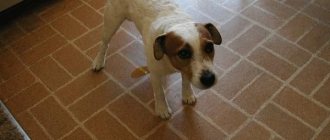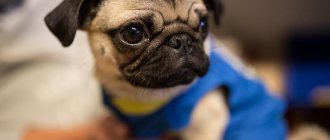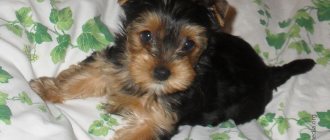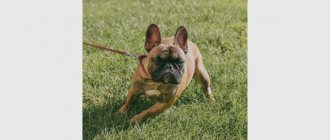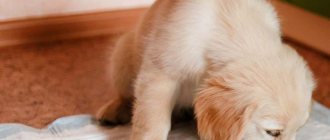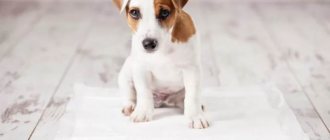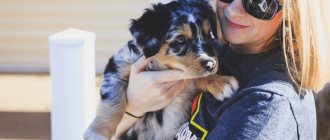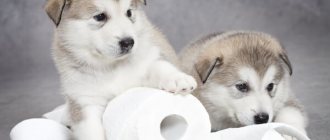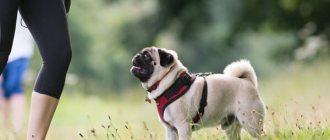The arrival of a puppy in the house is a great joy for all family members. And it is important, from the first days of a baby’s stay in a new family, to teach him the rules of behavior, which will subsequently become the fundamental norms of his life. One of these moments is training a puppy to use the toilet outside. How to properly organize the learning process to make it as effective and accessible to your pet as possible?
Experienced dog handlers offer a step-by-step solution to the problem. At the same time, the owner will need great patience and a certain amount of free time, which he is ready to devote to his four-legged friend. Only in this case can you count on a positive result.
At what age to start
Most kids strive to keep their environment clean. This is an innate instinct that domestic dogs have retained from their wild ancestors. It's rare to see a puppy go to the toilet on his bed.
Taking advantage of this innate habit, the owner must teach the baby to go to the tray or diaper from the first days of life. After all preventive vaccinations have been completed and the baby reaches the age of 3.5 months, you can gradually take him out for his first walks. It is very important to initially combine a pleasant and exciting time outside with bowel and bladder emptying.
One of the prerequisites for an effective pet training process will be a clearly established daily routine. You need to feed and walk your baby at strictly defined times. After just a few days, the young body gets used to receiving food at certain hours. The pet begins to produce gastric juice, and 15-20 minutes after eating, intestinal function is activated. Once the owner manages to accustom the puppy to a strict daily routine, the process will go much faster and more efficiently.
The process of accustoming a puppy to the street
Experienced dog handlers and veterinarians remind us that puppies of all breeds and ages go to the toilet in strictly defined situations:
- After sleep. If the baby has had enough sleep, then early in the morning and during the day you should immediately take him out onto the grass so that he can not only take a walk, but also make a couple of piles and puddles;
- After meal. 15-20 minutes after eating, intestinal peristalsis increases and the likelihood of creating a “surprise” in the form of a pile on the floor of the house increases significantly;
- After a long walk or game. If you decide to spend 30-40 minutes playing with the puppy, then remember: in the middle of the game the baby will definitely want to go to the toilet. Active physical activity also leads to increased peristalsis. So don’t forget to take a break and take your baby outside. If this is not possible, then simply take him to the tray or diaper. If you decide to take a long and exciting walk with your four-legged pet, then every 20-25 minutes give him the opportunity to walk quietly on the grass. Let him relieve the natural needs of the body in the right place, and not in the middle of the path or dog walking area.
- At a moment of strong fear or nervous tension . The baby is not yet able to control his urges and emotions, so when nervous, he can make a puddle. Remember this when you go to the veterinarian for an appointment or plan to visit noisy and crowded places with your four-legged pet.
To make the training process as effective as possible, you will need to devote all your free time to your baby. In all of the above situations, the pet should be immediately taken outside. This is important: if you notice that the baby begins to circle around itself and sniff the floor, you should immediately take your pet outside. You should not scold or punish your puppy, because he is not yet ready to control his urges.
Video
So, if you have a pet and you were able to teach him to wait until he goes for a walk and only perform his natural needs there, that’s great. But we must not forget that your pet needs constant attention from you. It happens that in order to attract the attention of the owner, the dog begins to pee at home. She does not do this to spite you, but simply gives a signal: something is going wrong, or it is an illness.
How did you train your dog? How quickly did you do it? What methods did you choose? What incentive methods did you use? How many times do you take your pet outside? Tell us in the comments, share your experience, so that it will be easier for those who are just starting this struggle.
How many times a day should you take your puppy outside?
Dog handlers recommend taking your baby outside after every nap and feeding. This will minimize the likelihood of unpleasant “surprises” appearing in an apartment or house. After your baby goes to the toilet, be sure to praise him, reward him with his favorite treat, and take him for a walk with other dogs.
The pet must clearly understand that initially he relieves himself on the street and only after that the exciting process of walking begins. Try to choose the most quiet and peaceful place for the toilet. It should be located away from playgrounds, public transport or places where pets can be walked. The main thing is that no one distracts or disturbs the baby at this crucial moment.
As soon as the baby learns to tolerate and relieve himself only on the street, you can gradually lengthen the intervals between walks. By the age of one year, an adult dog should go to the toilet 2-3 times a day and do this only outside. The exception is pets of miniature breeds, which the owner deliberately trains to relieve themselves in a special tray.
It is necessary to continue to strictly adhere to the daily routine. You are unlikely to be able to achieve impeccable pet behavior if during the work week the morning walk is carried out at 6-7 o'clock in the morning, and on weekends the owner strives to get enough sleep and postpones it for 8-9 hours. The pet simply does not understand why the owner does not take him for a walk. And if the owner ignores the animal’s increased activity and whining, then all efforts to train the puppy to use the toilet outside may come to nothing.
Taking care of your pet's health: the hidden dangers of walking
Walking is not only a lot of fun and positivity for the puppy, but also the risk of becoming infected with worms or external parasites. Therefore, preventive deworming should become the norm for your pet. A good solution for dogs with a short muzzle, as well as for capricious and biting pets who cannot easily give medicine by mouth, is the “Spot-on” form - drops on the withers. These drugs include Dironet® Spot-On for puppies. This is a medicine for external use in the form of drops. For treatment, it is used once, applied to the dry skin of the pet. For prevention, Dironet® Spot-On is used once a quarter or once every six months, depending on the dog’s lifestyle. This drug is suitable for puppies from 2 months of age.
How to teach a puppy to ask to go outside
To train a puppy to ask to go outside, the owner needs to devote maximum time to raising the baby. As soon as your pet starts circling around the room and whining, immediately take him outside. After the baby has done all the work in the indicated place, be sure to praise him.
After a short time, the dog will develop a conditioned reflex according to which the owner praises and gives a treat after the pet asks to go outside.
You should not ignore the restless behavior of the animal, even if the usual time for a walk has not yet arrived or the pet has recently returned from the street. Perhaps his normal digestion process has been disrupted and the risk of “mischief” at home increases. Careful observation of your pet's behavior allows you to make the training process effective and quick.
What to do if your dog pees with joy
Young dogs and older dogs are more often described as suffering from excess emotions. An explosion of delight is most often caused by the sight of the owner with a leash and the anticipation of a walk.
In puppies, anxiety can be treated with training. They must be taught to follow the command “sit” and “wait”. This usually has its effect, and the dog calms down.
An older dog also does not always restrain himself from excess emotions. Incontinence in aged dogs occurs due to senile changes, urolithiasis, and cystitis. It is recommended to show him to a veterinarian and give him a sedative. In this case, training will not help; the dog needs treatment and the love of its owner.
How to stop a puppy from peeing at home
If the owner devotes a lot of time to raising the pet, then after a few weeks the baby begins to regularly go to the toilet outside. But sometimes an animal can make a puddle or stops keeping the room clean. It is important to understand the reasons that led to the development of such a situation. This allows you to choose the most effective algorithm of actions to return to your usual routine.
Why does an older puppy start peeing at home again? Experienced dog handlers say that there are several main reasons:
- Malaise. Often, animals fed dry diets develop pathologies of the genitourinary system. The result is puddles that appear on the floor of a house or apartment between walks. It is also possible that the puppy is frozen and cannot control his urges.
- Resentment. Unfair punishment often becomes a reason to let a puddle fall on the owner’s rug or item of clothing. Try to restore friendly relations with your pet. This will be the key to cleanliness in the room.
- Stress. It can also cause your pet to pee on the floor again indoors.
The main thing in learning is consistency, patience and attentiveness. If your pet refuses to pee on the street, then you can use the advice of experts:
- Give your baby something to drink while walking. A large amount of fluid in the body will invariably become a reason for urination.
- Play and frolic actively with your puppy. The more intense the walk, the higher the likelihood that the animal will want to go to the toilet.
- Walk longer. Your pet will definitely go to the toilet during a long and exciting walk.
Why did the behavior change?
If a well-mannered dog suddenly begins to pee at home, it is recommended to inquire about the pet’s health. This behavior may indicate problems with the animal's health.
Severe frosts are considered the cause of severe diseases; this applies closely to representatives of decorative breeds, which even special clothing does not keep warm in cold weather.
It is known that bitches are capable of peeing at home for up to two years. According to experts, the main reasons for unwanted behavior are the hormonal system that is not fully formed. The reason is poor or unhealthy nutrition, bad heredity. Disturbances associated with the hormonal system return to normal after the first pregnancy.
Regarding the bad predisposition to such a bad habit, it is permissible to inquire from the breeders who gave away the puppy. You will be able to determine the reason for the incorrect behavior. Based on the facts obtained, it will become easier to wean your dog from peeing at home.
Reward and Punishment
There are several fundamental points to consider when training your pet:
- You cannot scold an animal for the piles and puddles that appear on the floor. The pet does not understand the reasons for the owner's dissatisfaction. Especially if the offense was committed earlier. The dog will simply conclude that he can’t shit in front of you. And if the owner caught the animal in the process of committing a mistake, then a sharply negative reaction from the owner will only lead to the fact that the animal may begin to eat its own excrement.
- You shouldn't poke your nose into the pile and hit. The animal becomes offended and stops trusting its owner. The consequence is a deterioration in the relationship between them and the learning process slows down significantly.
- Consistency and daily routine. Always take your pet out at the same time every day. There are no excuses to skip your usual walk.
- Don't skimp on your praise. If your pet did everything correctly and went to the toilet outside in the right place, express your joy and praise the animal. A good solution would be a treat that the puppy receives after a correctly performed action.
There are several effective ways to express your negative attitude towards the violation of cleanliness in the house:
- Strict tone. The pet must understand that you are unhappy and express your indignation. A ban on your favorite toy. She needs to be taken away and allowed to play only after the dog goes to the toilet outside in a strictly designated place.
- Using the “Fu” or “No” commands. As soon as your pet shows signs of anxiety and starts looking for a place in the house to urinate or defecate, immediately stop this behavior using these commands and a stern tone.
Remember that an attentive and caring attitude towards your pet allows you to make the learning process much more effective and faster!
